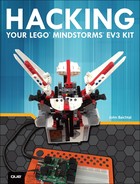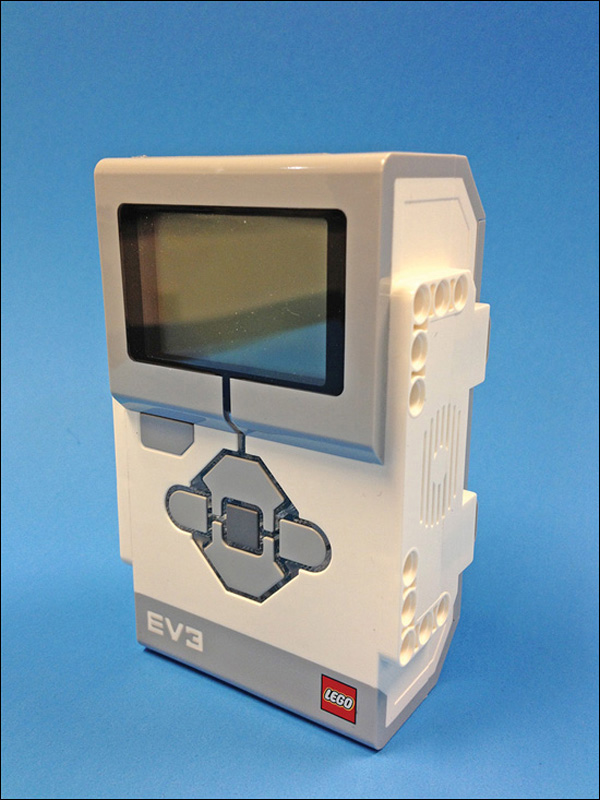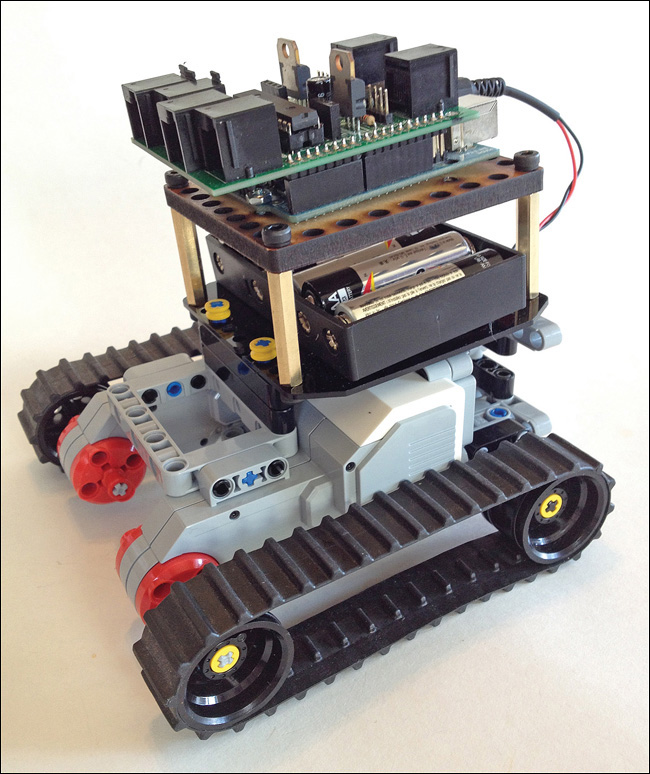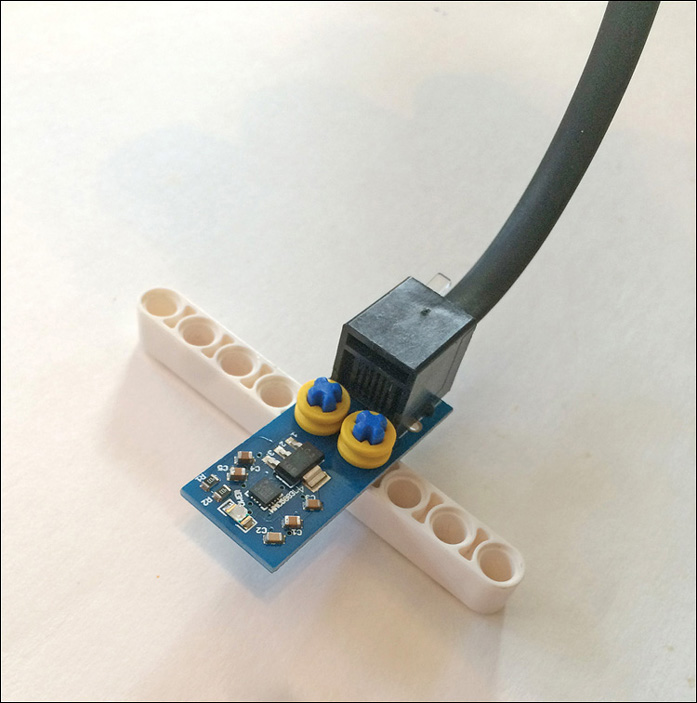1. Introduction
Building a robot teaches you a lot about engineering, electronics, and mechanics. That’s what the LEGO Group had in mind when it began developing its signature robotics set, Mindstorms, back in 1998.
The latest edition, LEGO Mindstorms EV3, represents the culmination of what the company learned from several unsuccessful robot sets. (Do Cybermaster or Spybotics sound familiar? Didn’t think so.) as well as the two previous editions of the Mindstorms product. Like its predecessors, EV3 consists of a plastic building set with compatible motors, sensors, and a microcontroller brick that runs everything (see Figure 1.1).
FIGURE 1.1 The EV3 Intelligent Brick follows a program to control your robot.
Mindstorms has come to be thought of as a stepping stone to “real” robotics because all the principles are the same. This so-called toy teaches you how to program a microcontroller, build gear assemblies, and create reinforced structures. If you want to learn about engineering principles, you can do a lot worse than Mindstorms.
Hacking Mindstorms
A robot-building set offers many possibilities, but there’s always room for more options. Sooner or later you get the idea you want to change something about the set. Maybe you need the perfect beam to complete your robot, but it’s a part not found in the Mindstorms inventory. Possibly you want to add a third-party sensor to your robot. Seems reasonable, right?
Well, not to everyone. Quite honestly, some perfectly sensible people are opposed to hacking the Mindstorms set in any way. The challenge for them is in accomplishing their objectives within the limitations of the set. They refuse to include any non-LEGO parts. They do not glue the pieces, nor cut or drill them.
Although I admire the tenacity and inventiveness of these stalwarts, I choose a different path: I just hack it. If the microcontroller doesn’t work the way I want it to, I reprogram it or use an Arduino instead, using the Bricktronics shield, shown in Figure 1.2, to control standard Mindstorms sensors and motors.
FIGURE 1.2 The Bricktronics shield interfaces LEGO’s proprietary motors and sensors with an Arduino.
I can add a third-party electronic module such as Dexter Industries’ dCompass to my model (see Figure 1.3), giving it the capability to tell what direction is north. This is just one example of dozens of cool products that you can purchase to accessorize your EV3 set.
If a part isn’t working for me, I modify it or replace it with another part that does work—even if I have to create the new one myself. The hole-studded boards in Figure 1.4 match up with LEGO hole spacing, enabling me to reinforce models or even make box-shaped enclosures.
Makeblock, another building set with Mindstorms-compatible hole spacing, not only gives you more parts to work with but adds much-needed strength and rigidity as its beams extrude out of aluminum.
Hacking your LEGO Mindstorms EV3 set has never been easier!
Chapter Topics
I just touched on a few of the possibilities. You learn many more techniques for making the most of your Mindstorms set:
![]() In Chapter 2, “Project: Plotter Bot,” you build the first project of the book, a drawing robot that decorates a 4x6 index card with a pen.
In Chapter 2, “Project: Plotter Bot,” you build the first project of the book, a drawing robot that decorates a 4x6 index card with a pen.
![]() It’s back to school in Chapter 3, “Hacking LEGO I: Connections,” where you learn about Mindstorms’ wires and how to hack them. The chapter also explores a bevy of wireless control options.
It’s back to school in Chapter 3, “Hacking LEGO I: Connections,” where you learn about Mindstorms’ wires and how to hack them. The chapter also explores a bevy of wireless control options.
![]() This know-how is put to good use in Chapter 4, “Project: Remote-Controlled Crane,” where you build a mobile crane that rolls along a railing and lowers a hook.
This know-how is put to good use in Chapter 4, “Project: Remote-Controlled Crane,” where you build a mobile crane that rolls along a railing and lowers a hook.
![]() Chapter 5, “Hacking LEGO II: Alternate Microcontrollers,” teaches you how to swap in Arduino microcontrollers and Raspberry Pi and BeagleBone Black microcomputers in place of the trusty but dull Mindstorms Intelligent Brick that ships with the set.
Chapter 5, “Hacking LEGO II: Alternate Microcontrollers,” teaches you how to swap in Arduino microcontrollers and Raspberry Pi and BeagleBone Black microcomputers in place of the trusty but dull Mindstorms Intelligent Brick that ships with the set.
![]() Chapter 6, “Project: Robot Flower,” shows you how to build a robotic flower using the Mindstorms Intelligent Brick as well as an Arduino microcontroller.
Chapter 6, “Project: Robot Flower,” shows you how to build a robotic flower using the Mindstorms Intelligent Brick as well as an Arduino microcontroller.
![]() Chapter 7, “Hacking LEGO III: Create Your Own LEGO Parts,” shows you how to 3D-print, laser, and mill your own LEGO-compatible beams when you can’t find that “perfect” part.
Chapter 7, “Hacking LEGO III: Create Your Own LEGO Parts,” shows you how to 3D-print, laser, and mill your own LEGO-compatible beams when you can’t find that “perfect” part.
![]() Chapter 8, “Project: Ball Contraption,” shows you how to create an intriguing device whose sole purpose is to route a LEGO ball around a series of chutes and ramps. You also have an opportunity to create a few simple LEGO-compatible parts to add on to your contraption.
Chapter 8, “Project: Ball Contraption,” shows you how to create an intriguing device whose sole purpose is to route a LEGO ball around a series of chutes and ramps. You also have an opportunity to create a few simple LEGO-compatible parts to add on to your contraption.
![]() In Chapter 9, “Hacking LEGO IV: Add-on Electronics,” you explore the variety of third-party sensors that you can control with your Mindstorms Intelligent Brick.
In Chapter 9, “Hacking LEGO IV: Add-on Electronics,” you explore the variety of third-party sensors that you can control with your Mindstorms Intelligent Brick.
![]() Chapter 10, “Project: Flagpole Climber,” shows you how to make a pole-climbing robot. You also learn how to hook up an altimeter so you know how far up it goes.
Chapter 10, “Project: Flagpole Climber,” shows you how to make a pole-climbing robot. You also learn how to hook up an altimeter so you know how far up it goes.
![]() The book concludes with a concise glossary to clarify any of those cryptic Mindstorms and robotics terms.
The book concludes with a concise glossary to clarify any of those cryptic Mindstorms and robotics terms.
This book is dedicated to exploring just a few of the amazing hacks out in the wild. Make robots, have fun, and don’t worry about building something perfect.




